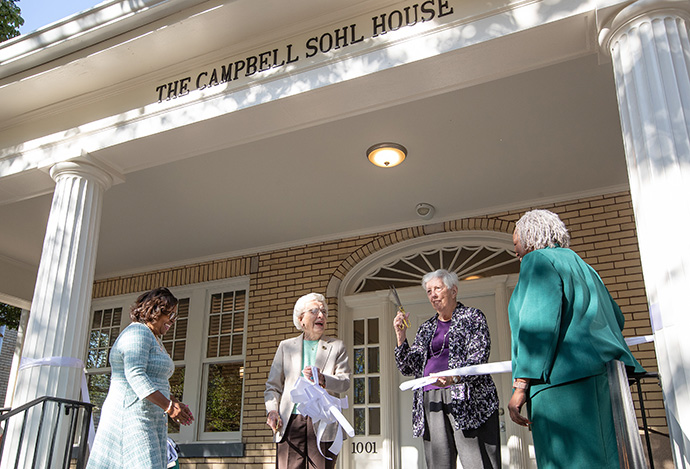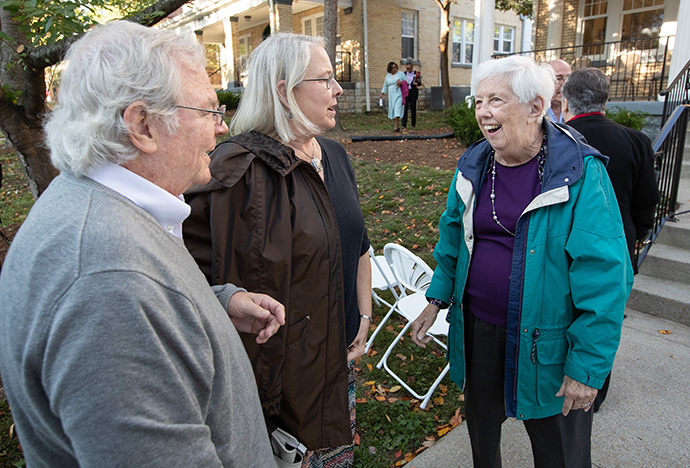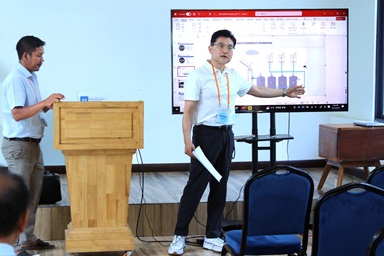Key points:
- When Scarritt College closed in 1988, a legal clause guaranteed the property would continue to be used for the original design of the owners and The United Methodist Church’s women’s organization retained the land.
- Now celebrating its 35th anniversary, a building was renamed to honor two of the women who devoted years of service to the Scarritt Bennett Center.
- The four-bedroom house and the Johnson Robinson House next door will be used for retreats, meetings and private stays. It can accommodate up to 10 guests.
When Scarritt College closed in 1988, some members of The United Methodist Church wanted to sell the historic property established by the Women’s Missionary Societies of the Methodist Episcopal Church South in 1892 for the purpose of educating young women.
Joyce Sohl was the treasurer of the Women’s Division of The United Methodist Church in 1982 and she knew selling the property would change the initial intent of the women who had bought and paid for every building on the property.
Women raised the money to establish the Bible and training college for young women missionaries in the late 1800s. It was during a time when most denominations prohibited women from being in leadership roles.
“Either the church or the state of Tennessee would not allow women to own the property,” recalls Sohl.
“But those women were smart,” she said of the college’s founders. They had a reverter clause that guaranteed the property would continue to be used for the original design, and the Women’s Division was the successor organization of Scarritt College.
“We had to deal with lawyers who had not read the document,” Sohl said. “They thought, ‘Oh, those crazy old ladies in New York won’t do anything.’”
“Yeah, sure,” she said with a laugh.

On a bright fall day, Sohl and Barbara Campbell sat on the front porch of a historic house at the corner of 18th Avenue and Grand Street, under a sign designating it the Campbell Sohl House as part of the 35th anniversary of Scarritt Bennett Center.
At the Oct. 20 dedication, the Rev. Sondrea Tolbert, executive director of the center, said, “If it were not for the women, where would we be?”
Tolbert said the house was being named for two women who made sure the naming and purpose of the Scarritt Bennett Center remained true to the values of those who came before.
The center sits on over 10 acres in an ever-growing city full of high-rise buildings. Its 10 buildings and six houses are all named for women, Tolbert said.

Campbell received her bachelor’s and master’s degrees from Scarritt College in 1953 and 1954. She was a member and president of the Scarritt Bennett Center board of directors in 1994 and served as interim president in 2005. She is the author of “United Methodist Women: In the Middle of Tomorrow” and “To Educate Is To Teach To Live.”
Tolbert said when she was talking to Campbell about naming the building, Campbell said, “I don’t care what you name it, just name it after a woman!”
Speaking after the ribbon cutting, Campbell said, “It really is a daunting experience to have my name linked with the founders of this place. Over the years, I was always keeping my eyes on this place.”
The four-bedroom house and the Johnson Robinson House next door will be used for retreats, meetings and private stays. It can accommodate up to 10 guests.

In 2010, Sohl moved to Nashville and became the first full-time volunteer for the Scarritt Bennett Center. During her tenure, she started a Poet’s Corner, art exhibits, Vespers and All That Jazz, Tuesdays in the Chapel and spiritual retreats.
“I was able to do programs instead of administration,” she said.
Sohl’s life has put her in the center of taking up for women’s rights all around the globe.
She grew up in the Evangelical United Brethren Church and served on the EUB’s Women’s Council and Board of Missions before that denomination’s merger with the Methodist Church in 1968 that created The United Methodist Church.

Theressa Hoover, then head of the Women’s Division, recruited Sohl and “insisted I get involved with finances,” she said.
Sohl went on to chair the finance department of the Women’s Division and was on the finance committee of the United Methodist Board of Global Ministries.
“Some people had trouble with me. I was the youngest thing they had seen,” she said, laughing. “And then I got pregnant while in that role, and the old ladies had a hard time with that.”
Other church leaders had trouble with Sohl as well.
Subscribe to our
e-newsletter
During her tenure, she had to deal with world leaders in the Philippines and Korea who were ordering all foreign property owners to get rid of their property.
“What we did was deed the property to various women’s organizations (in the two countries) and that upset the bishops because they thought they should have it.”
Sohl helped keep important properties such as hospitals, schools, women’s centers and community centers within the Women’s Division.
She also addressed many controversial issues such as racism, abortion, sexuality and wide-ranging political perspectives.
“I saw a lot of the world, made it to every state in the union and met some fabulous people along the way,” she said.
Sohl carried on the work started by Hoover to make the Women’s Division of The United Methodist Church an independent, autonomous institution. That became reality in 2012 during the tenure of Harriett Jane Olsen.
After her retirement in 2004, Sohl became active in the Global Praise movement. “Along the way, I wrote books, did this and that and the other,” she said.
The 87-year-old now lives in Bentonville, Arkansas, to be near family. However, she continues to coordinate Sunday Vespers and All That Jazz through email and phone calls.
Gilbert is a freelance writer in Nashville, Tenn. News media contact: Julie Dwyer at (615) 742-5470 or [email protected]. To read more United Methodist news, subscribe to the free Daily or Weekly Digests.




